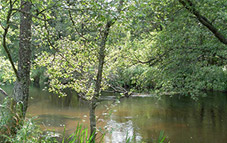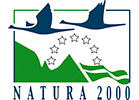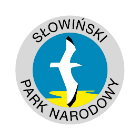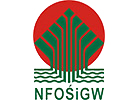
This project is a tool for the implementation of the provisions of Directive 92/43/EEC on the protection of natural habitats and of wild fauna and flora and Directive 79/409/EEC on the protection of wild birds. The subject of the project is primarily active protection of habitats and species described below.
The habitats:
Within SOO Ostoja Słowińska (PLH220023) up to 50% of the area is occupied by the habitats listed in Annex I of Directive 92/43/EEC on the protection of natural habitats and wild fauna and flora. The planned activities of the project will directly affect the three natural habitats:
- *91E0-3 alder and ash riverside forests – the forest habitat whose presence is dependent on the presence of floods (annual ones or once every couple of years) of the river waters or on moving groundwater. Drying or too long stagnation of water on the area of a habitat leads to changes in vegetation, and in effect, to the loss of natural values. The effective protection of the riparian forests depends on the maintaining of specific water relations and therefore the greatest threat to this habitat is drying of the valleys and riverbeds regulation.
- 3150-2 eutrophic oxbow lakes and small water reservoirs represented by 7 water reservoirs located in the Łupawa river valley above the village of Smołdzino. The state of preservation of the objects is generally insufficient. The habitat occupies a total area of 1,15 hectare.
- 3260-1 foothill and lowland rivers with the groups of common water-crowfoots Ranunculetum fluitantis. The state of preservation of the subject of protection is far from optimal because the section of the river in a range of habitat has been regulated and embanked. The area of the habitat covered by the project activities is 2,70 hectares.
The birds:
The polders of the Gardno lake IX and X are on the scale of the region (the Middle Pomerania) one of the most important breeding, feeding and bed sites for the birds connected with the water-meadow environment, mainly Charadriiformes and Anseriformes birds.
Thanks to active protection of the habitats for the last three years there has been an increase in the population of those groups of birds. The open areas of which the polders are have become attractive to such species of birds from the Annex I and II of Directive 79/409/EEC, as follows:
The Lapwing (Vanellus vanellus) - In Poland the estimated population of this species is 100-150 thousand pairs. During the breeding season it is related, primarily, with open areas covered with low vegetation. It prefers meadows flooded periodically. The population of lapwings in Słowiński National Park and PLB 220023 Pobrzeże Słowińskie is assessed for the quantity of 20 nesting pairs of which the Polder of the Gardno lake IX is one of the most important for this species. There are 8 nesting pairs.
The Common Redshank (Tringa totanus) - In Poland the common redshank is mainly nesting in the valleys of large lowland rivers in the central and eastern part of the country. Breeding sites of the common redshank cover open sites and as in the case of lapwings it prefers the periodically flooded meadows.
The “Słowiński” population is estimated for 7-8 pairs and is thus one of the few in Pomerania. The polder of the Gardno lake IX and X, is one of the 4 places of occurrence of this species in the breeding season. In Poland the number of this species is estimated for 2000-2500 pairs.
The Common snipe (Gallinago gallinago) - The primary habitat of this species are open or partially bushy wet meadows and pastures, sedges and bogs. A condition for nesting of this snipe is the presence of pieces with stagnating, shallow water. The Słowiński National Park and, in particular, the polders are a mainstay of the species. The number of this species in the Park, is estimated at 20-25 pairs.
The Spotted crake (Porzana porzana) – It nests on wet meadows and sedges by the banks of the eutrophic lakes, ponds and oxbow lakes. In Poland this species is endangered and is subject to significant fluctuations of abundance which is associated with a variable level of waters.
The polders of the Gardno lake IX and X, thanks to persisting of relevant level of the water in the breeding period creates favourable conditions for the life of the chickie.
The Corncrake (Crex crex) - The species widespread in Europe, outside the Mediterranean areas, which it avoids. There is a possibility to meet the Corncrake on the open areas. It prefers wet meadows, low bogs with a high grassy vegetation. On the polders of the Gardno lake up to 5 calling males were identified.
The Garganey (Anas querquedula) - The primary breeding habitat of the garganey in our country are extensive flood plains hay meadows and pastures in the valleys of the rivers with the floods. The abundance in Poland is estimated for 2000-3000 pairs. The polders of the Gardno lake are an important nesting place in the region scale of this meadowgrass duck. The number is estimated for 7-12 pairs.
The Northern Shoveler (Anas clypeata) - A typical habitat of the Northern Shoveler are, like for the Garganey, floodplain meadows and pastures. The species also nests near shallow eutrophic lakes.
The Polish population of this species is determined on 1500-2000 pairs. Also, like the Garganey – the polders are important in the scale of the region for this species. Currently the population is estimated for 1-2 pairs. Low vegetation and appropriate water relations are attractive for the birds not only in the breeding season but also during their migration.
In the spring one can observe significant concentrations of the European golden plover (Pluvialis apricaria) - 2500 individuals. The important in the scale of a region or country are clusters of geese: the Bean goose (Anser fabalis) and the Greater white-fronted goose (Anser albifrons).
Occurring in spring, the ducks on the flights, there are mainly: Eurasian widgeon (Anas penelope), /500 individuals/, the Northern Shoveler (Anas clypeata), /120 individuals/, the Pintail (Anas acuta), /110 individuals/, the Eurasian teal (Anas crecca), /600 individuals/, the Gadwall (Anas strepera) /40 individuals/.
In addition, in the waters adjacent to the Polders there stop while migrating: the Whooper swan (Cygnus cygnus) 150-200 birds, the Tundra Swan (Cygnus columbianus) – several dozens of individuals, the Common crane (Grus Grus) – the herds coming to 1.5 thousand individuals (in the autumn).
Other migratory birds: the Curlew (Numenius arquata), the Black-tailed godwit (Limosa limosa), the Whimbrel (Numenius phaeopus), the Common Greenshank (Tringa nebularia), the Wood sandpiper (Tringa glareola), the Spotted Redshank (Tringa erythropus), the Ruff (Philomachus pugnax). All these species are protected by law and are subject to the protection of the species.
The fish:
The project will largely affect the following five species of fish and Lampreys which are listed in Annex II of the Habitats Directive:
The Brook lamprey (Lampetra planeri) - individual specimens were found during monitoring catches on the stretch of the Łupawa river just over Smołdzino. The brook lamprey do not escape to the sea, the larvae live buried in river sediments for a period of 3-6 years. In the country the species is covered by the strict protection.
The European river lamprey (Lampetra fluviatilis) is a diadromous species, the adults are staying in the sea, but to spawn they come to rivers. The larvae, as in the case of the above described species also live in river sediments for several years. This species occurs in the waters of the Gardno lake and the Łupawa river, however, this river is an important place of occurrence of the species in the country. This lamprey is strictly protected.
Salmon (Salmo salar) is a diadromous species whose reproductive cycle is associated with rivers and streams of the arenaceous and stony bottom with a fast flow of well oxygenated water. In recent years there is a little presence of the species in the waters of the Gardno lake and the Łupawa river. The species is partly protected.
The Amur bitterling (Rhodeus sericeus amarus) is the only representative of the fish in the Polish waters that its reproductive cycle is closely tied with mussels from the Unionidae family (Unioidae). The representatives of the species mostly occur in the western oxbow lakes of the Łupawa river, over Smołdzino village. The species is subject to strict protection.
The European weatherfish (Misgurnus fossilis) – It prefers the habitats with mud bottoms, and thanks to the possibility of intestinal respiration is able to occupy a site of low oxygen content inaccessible to other fish. The main site of occurring in the project area are canals and ditches of water drainage in the polder of the Gardno IX. The species is subject to strict protection.
The Eel (Anguilla Anguilla) is a predatory species which breeds in marine waters. In Poland in the past it was a widespread species, however, as a result of the damming of the rivers a range of occurring is confined to the Lake District and the coastal lowlands.
Due to the presence of the two largest coastal lakes (the Gardno and Łebsko), the Słowiński Special Protection Area PLH220023 is one of the most important places of occurrence of the species in Poland.
In 2007 the Council of the European Union, by the provisions of Regulation (EC) No. 1100/2007 establishing measures for the reconstruction of the European eel introduced an obligation for the Member States of the European Union to take action to protect this endangered species.
However, this species is not listed in any of the annexes to Council Directive 92/43/EEC. In accordance with the assessment of the International Union for Conservation of Nature (IUCN) the eel has the status (CR) of species critically threatened with extinction.















